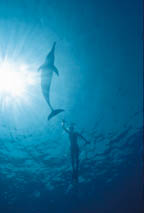|
FREEDIVE! by Terry Maas and David Sipperly Freediving
Photography Freediving offers a multitude of opportunities for capturing
magnificent underwater images of shy, elusive subjects. Whether it's with a still camera
or a video recorder, silent, graceful freedivers often produce pictures others miss. Many
world-class underwater photographers have set aside their scuba gear in search of better
pictures. A short list includes such greats as Bill Boyce, Al Giddings, Howard Hall, Chuck
and Flip Nicklin, Doug Perrine, Rick Rosenthal, Brian Skerry, James D. Watt and Norbert
Wu.
The most colorful images are made on sunny days in shallow water with the subject next to the lens. Wide-angle lenses allow you to get close enough for quality color, yet they don't cut off parts of your subject, like narrower angled lenses do. By brushing water across the lens surface with your hand, you can remove small air bubbles that collect, especially just after entering the water or encountering foamy surface water. Don't touch the lens-you might leave streaks. Amber color-correction filters, by selectively blocking the blues, help restore color to pictures shot through a long water column.............
Phil considers the Nikonos-V camera the best choice for
freedivers because it’s small, light and versatile. Its ease of operation decreases
the confusion in exciting situations. You can even use this camera “shooting from the
hip.” Phil knows of a diver who holds his camera at arms length for dolphin photos
and manages to center 80 percent of his images without the viewfinder. The trick is to
mark an “X” (diagonally from corner to corner) on the back of the backplat to
locate the center of the camera. Simply aim the “X” at your subject and shoot. Patience and proximity: One of the first rules of underwater photography is to “get
close” in order to improve the clarity of your subject and add impact to the
composition. With regard to timid bluewater animals, marine mammals and compliance with
the Marine Mammal Protection and Endangered Species Act, a good policy is to give your
subject the chance to come to you. Allow the curiosity of your subject to initiate
contact. The approach may never come, but if it does, you will be rewarded with longer,
more intimate encounters and much better image opportunities. The alternative rushed
approach usually causes the subject to flee, and in the case of protected marine mammals,
might violate anti-harassment laws.
|


